

Top Fifty IF Stories for Kids - Teaching and Learning With Interactive FictionTeaching and Learning With Interactive Fiction. The Top Fifty-One Works of Interactive Fiction (In One Person’s Opinion) For People Aged 10-16, and Older If you’re having trouble finding a story on the Interactive Fiction Archive, search for it in The Interactive Fiction Database ( In fact, you may be happier if you simply start at the IF Database.
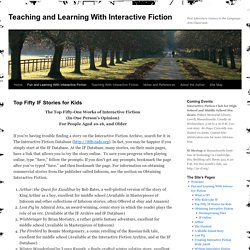
At the IF Database, many stories, on their main pages, have a link that allows you to try the story online. To save your progress when playing online, type “Save,” follow the prompts. If you don’t get any prompts, bookmark the page after you’ve typed “Save.” and then bookmark the page. 10 of the best examples of digital literature. These days all text is digital.
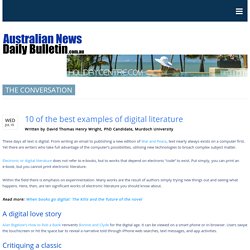
From writing an email to publishing a new edition of War and Peace, text nearly always exists on a computer first. Yet there are writers who take full advantage of the computer’s possibilities, utilising new technologies to broach complex subject matter. Electronic or digital literature does not refer to e-books, but to works that depend on electronic “code” to exist. Put simply, you can print an e-book, but you cannot print electronic literature. 13 Great Webcomics For Kids and Teens. How Minecraft is helping kids fall in love with books. Robert Louis Stevenson’s 1881 classic Treasure Island tells of Jim Hawkins’s adventures on board the Hispaniola, as he and his crew – along with double-crossing pirate Long John Silver – set out to find Captain Flint’s missing treasure on Skeleton Island.
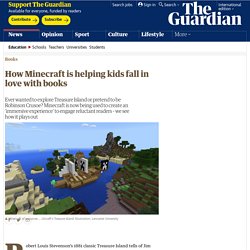
Now, more than a century later, children can try and find it themselves, with the bays and mountains of Stevenson’s fictional island given a blocky remodelling in Minecraft, as part of a new project aimed at bringing reluctant readers to literary classics. From Spyglass Hill to Ben Gunn’s cave, children can explore every nook and cranny of Skeleton Island as part of Litcraft, a new partnership between Lancaster University and Microsoft, which bought the game for $2.5bn (£1.9bn) in 2015 and which is now played by 74 million people each month. She says, of the Litcraft Treasure Island: “We hope it will motivate reluctant readers – we can say, ‘We’re going to read the book and then at one point, we’ll go play on the ship.’
Insta Novels: Bringing Classic Literature to Instagram Stories. Introducing Insta Novels, a reimagining of Instagram Stories to provide a new platform for iconic stories. Insta Novels launched today on the Library's Instagram account (@nypl) with Part 1 of a newly digitized version of Alice's Adventures in Wonderland by Lewis Carroll. The novel is illustrated by well-known designer Magoz (@magoz). In the coming months, look for two other literary works that will be released on the Library's Instagram account: "The Yellow Wallpaper," a short story by Charlotte Perkins Gilman illustrated by Buck (@buck_design) and The Metamorphosis, a novella by Franz Kafka illustrated by César Pelizer (@cesarpelizer). The New York Public Library joined forces with the independent advertising and creative agency, Mother in New York, to create Insta Novels.
The program aims to make great stories available even more widely. College Students Prefer Print for Long-form Reading, Ebooks for Research. Stagnant and dull, can digital books ever replace print? From 2009 to 2013, every book I read, I read on a screen.
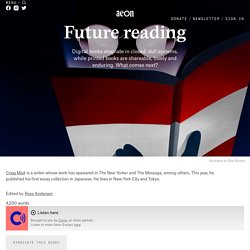
And then I stopped. You could call my four years of devout screen‑reading an experiment. I felt a duty – not to anyone or anything specifically, but more vaguely to the idea of ‘books’. The byte may destroy the book but the novel isn't over yet. In This Will Destroy That, also known as Book V, Chapter 2 of Notre Dame de Paris, Victor Hugo presents his famous argument that it was the invention of the printing press that destroyed the edifice of the gothic cathedral.
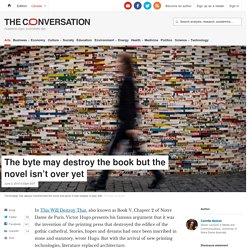
Stories, hopes and dreams had once been inscribed in stone and statutory, wrote Hugo. But with the arrival of new printing technologies, literature replaced architecture. Today, “this” may well be destroying “that” again, as the Galaxy of the Internet replaces the Gutenberg Universe. Where are the books? Libraries under fire as they shift from print to digital.
The hallmark of public libraries — the printed book, bound by covers and centuries of page-turning — is being shoved aside by digital doppelgangers.
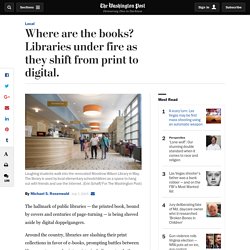
Around the country, libraries are slashing their print collections in favor of e-books, prompting battles between library systems and print purists, including not only the pre-pixel generation but digital natives who represent a sizable portion of the 1.5 billion library visits a year and prefer print for serious reading. [Millennials prefer reading in print.
Yes, you read that right.] Ebooks are changing the way we read, and the way novelists write. If you hand me the original paperback edition of Thomas Pynchon’s Gravity’s Rainbow I can, quickly and without too much scrabbling, find you the page where the hero loses the girl.
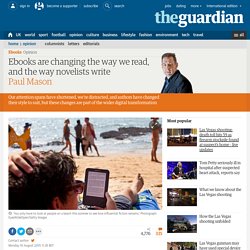
My disappointment on his behalf has lingered physically on that page for the past 20 years. Likewise, in Vasily Grossman’s Life and Fate, there is a long section where a platoon of the Red Army defends “House 6/1”, establishing a temporary zone of political freedom there. The 8 Digital Literacy Practices Required for 21st Century Learners.
January 4, 2015 Theoretically speaking, digital literacy is a concept that is in constant flux.

It is perpetually shifting and expanding to include new practices and skills afforded by new emerging technologies. In their excellent book "Understanding Digital Literacies: A Practical Introduction", authors Jones and Hafner provide a detailed analysis of what it means to be a digitally literate in the light of the social media revolution and the widespread of web 2.0 technologies. As I was perusing it today, I came across this section in chapter one where the authors talk about the different digital literacy practices that are required to thrive in this digitally-focused era. Here is a quick overview of these practices: Edutopia. Multiple Journalism. A view in text and visuals of the history of bush fires in Australia.
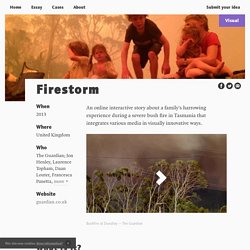
Did technology kill the book or give it new life? Image copyright lostmyname The book is dead, long live the book.

Digital technology has certainly had a profound effect on the traditional book publishing and retailing industries, but has it also given the book a new lease of life? At one point it looked as if the rise of e-books at knock-down prices and e-readers like Amazon's Kindle and Barnes & Noble's Nook posed an existential threat to book publishers and sellers. Why the Guardian’s ‘Firestorm’ is better than the Times’ ‘Snowfall’
A Case for Using iBooks in Your Classroom. Digital vs Print: Taking a Position as an Academic Librarian. As collections transition to digital and print finds its way into remote storage sites, how does our profession respond to research that favors print over digital for reading comprehension, learning, and meeting student preferences? Whether we are intentional about it or when events beyond our control force it on us, academic librarians are experiencing a shift from print to digital. At my own library, print periodicals were once so voluminous they required their own 5,000 square foot space. Now you can walk by what remains of it in seconds, barely noticing the existence of a print journal collection.
Just recently, we added 200,000 ebooks as part of a consortial collection. Our new bookshelves fill up with fresh print titles every week, a sign that the predicted death of print is unlikely to occur anytime in the not-so-near future. Nik's QuickShout: Create Texting Fiction to Keep Your Teens Engaged. Texting fiction is a new emergent genre of fiction writing that is becoming very popular among teens and I have to say when I started reading a few of these creations I can see why. Basically the narrative is structured as a phone based text conversation and can include images and videos as well as text and audio messages. The reader taps their way through the messages as a kind of voyeur, following the interaction between the two people to build their understanding of the story. The most popular platforms at present for marketing this type of genre are: These apps are freemium and allow you to download and read through the narrative, but if you are on a free version you may have to wait a few hours for the next part of the story or in some cases you don't get some of the rich media elements of the story.
Do students lose depth in digital reading? Theconversation. Digital Storytelling Wheel for Teachers. Do You Read Differently Online and in Print? Children prefer to read books on paper rather than screens. 5 Great eBook Libraries for Kids. Nick Earls successfully takes on dark art of digital publishing with novella experiment. 6 Great Examples of Digital Storytelling - 8MS Blog. Strategies to Help Students ‘Go Deep’ When Reading Digitally.
Why Podcasts Like 'Serial' Are Helping English Teachers Encourage Literacy. Top Ways for Kids to Tell Digital Stories. Reading in 2016 – digital vs print, the ultimate smackdown! – Linking Learning. Do students lose depth in digital reading? Podcast Party: A Curated List of Nine Teen-Friendly Podcasts. 50 of Our Best. Student perspectives on ebook and audiobook usage. 13 Great Webcomics For Kids and Teens. Digital Literature. Webcomics World.